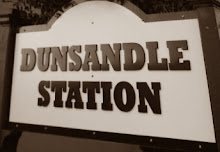From Baronial Lines Of The Midland Great Western Railway - O'Cuimin, Padraig - 1972, ISBN 0-901552-00-3
Dunsandle, at MP 111 ¼, is now a halt, though until 1931 it was a station and until 1926, a block post with a signal cabin. The present layout consists of a single platform with station buildings on the up side, and a siding, facing to up trains, on the down side; it is protected by trap point and shunting disc. This is almost the arrangement when the line was opened, though there was at that time a good loop with an extension towards the crossing gates. When the ballast hill was opened in 1896, the spur siding was done away with and the loop extended northwards. An entrance to the hill was made by taking a long siding off the loop at the crossing end, and taking this across an intervening field and the Kiltulla-Bullaun road to the pit.
There was an elaborate signalling layout as required by the Board of Trade regulations. The cabin had an 8-lever frame controlling two sets of distant home and starting signals for the two directions, the interlocked point, trap point and disc at the Loughrea end and the gate locks. The ballast pit siding was controlled by a ground frame with three levers, unlocked by a key from the cabin. A ringed siding signal was connected to a trap point protecting the exit from the ballast siding and a similar trap, linked to a ground disc, covered the northern end of the loop immediately before the junction with the ballast siding and a similar trap, linked to a ground disc, covered the northern ens of the loop immediately before the junction with the ballast siding. When the pit was closed, the ballast siding was shortened to a mere spur, about 180 ft long, and the signally naturally simplified. The distants were fixed at danger, the ringed signal dispensed with. Possibly at this time, the southern points were controlled by a ground frame. The third major change was in 1931 when the cabin was taken away, the distants removed, and the ground frame transferred to work the crossing gates, signal and north end of the loop. The spur siding was worked by a tumbler. The remained the signalling position until the recent removal of the connection at the crossing end of the loop and the lifting of the spur siding.

The station house, on the 230ft platform, is stone-built with a slated roof. It consists of a two storey dwelling house and single storey offices. The latter comprise booking office, waiting room, ladies' waiting room, and outside men's toilet. The stone-built goods shed is opposite the station house on a loading bank some 50 ft long. The shed measures 30 ft by 12 ft internally and it and the main building are to the same design as the buildings at Hollymount. There was, in earlier years, a crane on the goods bank, to the south of the shed. This was listed in the 1923 Appendix to the Working Timetables as of 1 ton 10 cwt capacity. Another feature of Midland days which has disappeared was a lamp room of timber frame and corrigated iron construction, originally put up in 1909. This was erected on the platform near the signal cabin.
The line leaves Dunsandle through a shallow cutting, from the down side of which ballast was taken in the early years of the line. There is a fall of 1:100 for 1 mile followed by a short level length and a climb at 1:80 to just past MP 1121. This is Tooloban bank, the most considerable gradient on the line. The line has been straight to Tooloban gates but curves to the right when an up signal is seen high on the steep bank. The stone-built overbridge carrying the public road from Knocknadaula to the L99 at Dunsandle House is near MP 1121. From the summit of the bank, there is a level as far as MP 113, where another rise of 1:1000 begins; the line is now generally straight, deviating from side to side occasionally. Curving to the left after MP 1131, the signal from Lynchford crossing is passed; the gates are sited at the 1131 mile post. A final turn to the right reveals the fixed distant for Loughrea station. Before 1918, this signal was operated from the cabin there. The line enters the final straight at 1151, and is level into the station. From MP 114 the line has climbed steadily; first at 1:267 increasing to 1:115 at MP 115. Another signal on the down side protects the crossing gates at the entrance to the station yard, known as Cosmona or Loughrea crossing.



